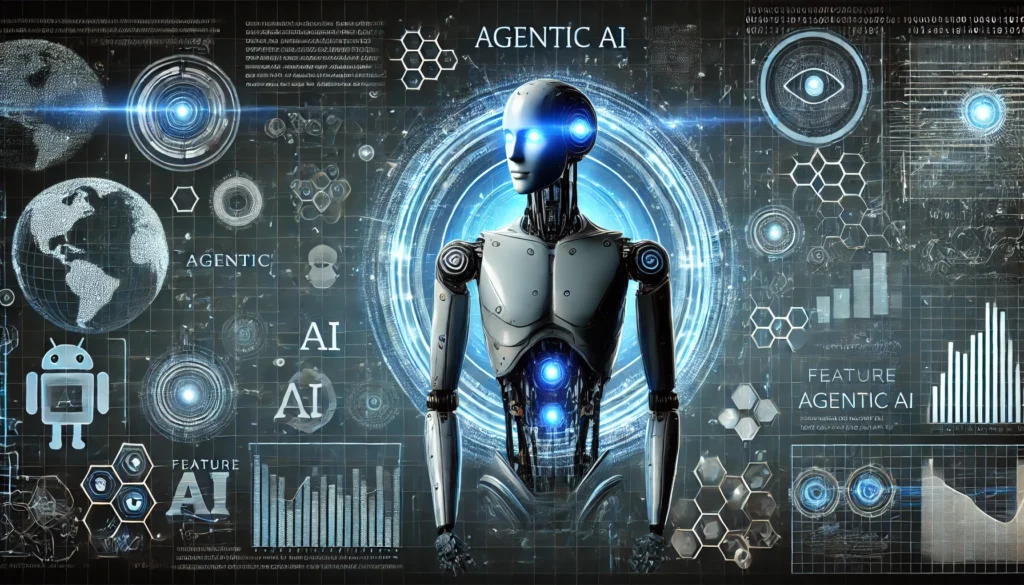Introduction
Agentic AI is reshaping the AI landscape by introducing advanced reasoning and problem-solving capabilities. Unlike traditional AI, agentic AI can independently analyze, plan, execute, and improve through feedback. This article explores how agentic AI works, its core components, and its potential to revolutionize industries.

What is Agentic AI?
Agentic AI refers to artificial intelligence systems that can perform complex, multi-step tasks autonomously. Unlike conventional AI, which relies on pre-defined instructions, agentic AI combines perception, reasoning, execution, and learning to handle dynamic situations.
How Agentic AI Works
Agentic AI follows a structured four-step process:
- Perception: The AI system collects and processes data from various sources, including text, images, and real-world interactions.
- Reasoning: Using large language models (LLMs), the AI interprets the data and creates a strategy to address the problem.
- Execution: The AI performs the necessary actions, such as automating tasks, interacting with users, or adjusting processes.
- Learning: The system evaluates the results and refines its approach to improve future performance.
Key Technologies Behind Agentic AI
Agentic AI relies on several cutting-edge technologies:
- Large Language Models (LLMs): Provide deep language understanding and reasoning.
- NeMo Microservices: NVIDIA’s platform for developing and scaling AI applications.
- Reinforcement Learning: Enables AI to learn and adapt based on feedback.
- Multimodal Capabilities: Allows AI to process and integrate data from different formats (text, images, speech).
Applications of Agentic AI
Agentic AI is already transforming various industries:
1. Customer Service
Agentic AI enables automated chatbots to handle complex customer queries, improving response time and accuracy.
2. Healthcare
AI systems assist doctors in diagnosing diseases, recommending treatments, and managing patient care more effectively.
3. Software Development
Agentic AI automates code generation, testing, and debugging, reducing development time.
4. Finance
AI algorithms manage trading strategies, fraud detection, and customer support with minimal human intervention.
Advantages of Agentic AI
- Enhanced Efficiency: Automates complex processes, reducing human effort and time.
- Continuous Improvement: Learns from mistakes and feedback to optimize performance.
- Adaptability: Handles new and unforeseen challenges with minimal human guidance.
Challenges and Limitations
While agentic AI shows great promise, it comes with challenges:
- Data Privacy and Security: Managing sensitive information raises ethical concerns.
- Bias and Fairness: AI models can reflect biases in training data.
- Computational Costs: Running complex AI models requires significant processing power and resources.
How NVIDIA is Leading the Agentic AI Revolution
NVIDIA is at the forefront of agentic AI development with its NeMo platform and AI infrastructure. NeMo microservices enable developers to create and customize agentic AI models tailored to specific business needs. NVIDIA’s hardware accelerators and AI frameworks provide the computational power needed for large-scale deployment.
Future of Agentic AI
The future of agentic AI looks promising, with advancements in LLMs, multimodal models, and reinforcement learning. AI is expected to become more autonomous, capable of handling complex decision-making across industries.
Conclusion
Agentic AI represents a significant leap forward in AI capabilities. By combining perception, reasoning, execution, and learning, agentic AI can solve complex problems with minimal human input. NVIDIA’s innovations in AI infrastructure are accelerating this shift, positioning agentic AI as a transformative force in the coming years.
Check More
- Why controlling generative AI matters for ethical
- AI in healthcare AI istransforming the medical field
- How ai companions can turn into tyranny

